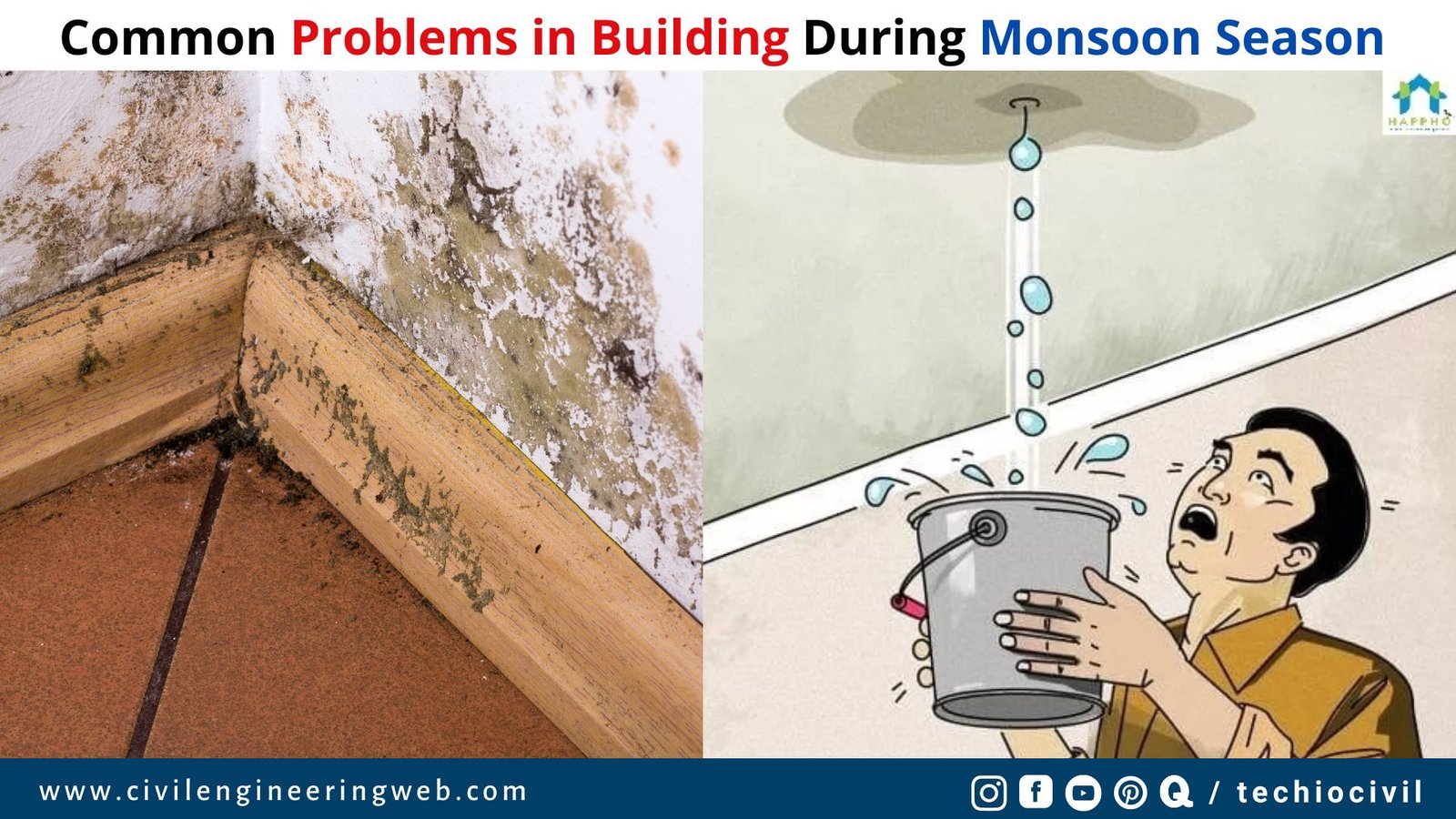In this article, we explain major problems in building during rainy season, such as roof leakage, loose-blow roof tiles, wall damages, gutter drain clogs, roof vegetation, dampness in the basement, short circuits, and moss, etc. Learn about the causes behind these issues and find effective solutions to address them. Ensure your building is well-prepared for the monsoon with essential pre-monsoon maintenance tips.
Table of Contents
Problems in Building during Rainy season
Here are the few major problems in building/house during rainy season.
- Roof leakage
- Loose-blow roof tiles
- Wall Damage and leakage
- Gutter drain clog
- Roof Vegetation
- Dampness in Basement
- Shot circuit
- Moss
1. Roof Leakage
Roof Leakage is very common problem during rainy season. And almost 90% of home facing this problem in rainy season.

Here are the major causes of roof leakage in rainy season.
Cracks in Roof: Cracks are the primary cause of roof leakage. In RCC/Concrete structures, there are often minor cracks present in the structure that are not visible to the naked eye, but they still contribute to roof leakage.
Additionally, inadequate routine maintenance can result in roof degradation and the formation of major cracks, which leads to water leakage.
Also Read: Different types of cracks in concrete and remedial measures
Water Accumulation: This problem occurs due to an improper slope of the roof, which causes water to accumulate in different areas. Ultimately, this leads to roof leakage.
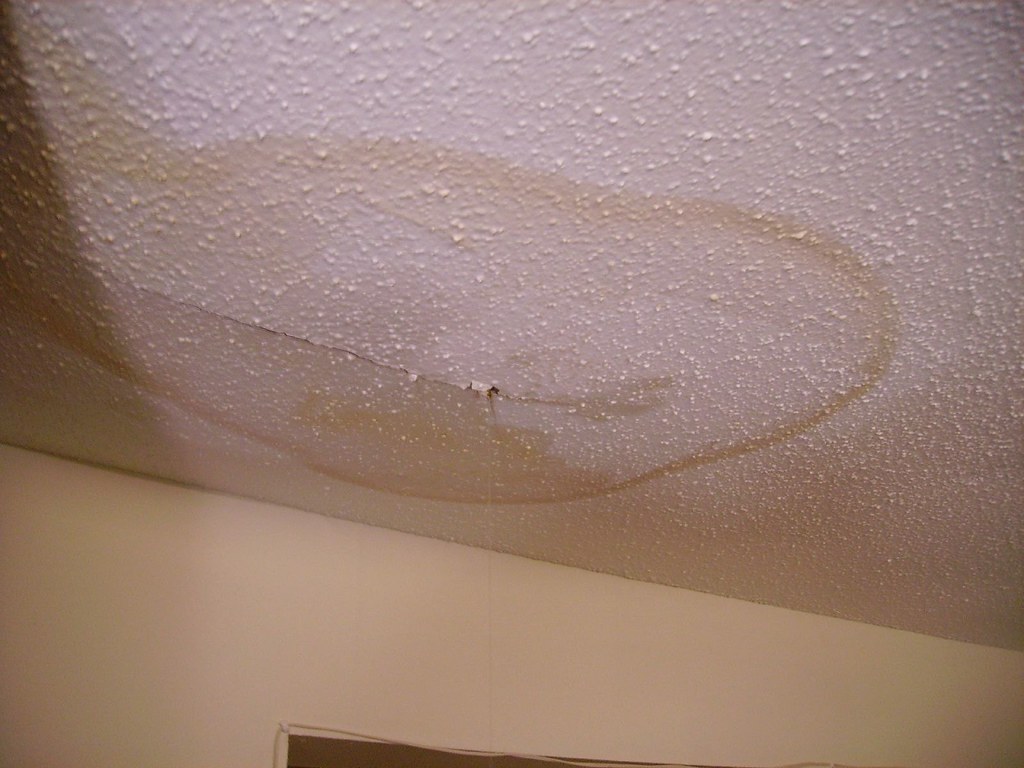
Improper Drainage: Drainage is also a significant cause of roof leakage. A clogged, faulty, or broken drainage system can lead to water leaking into the roof or floor, resulting in water inside the room and the formation of unwanted stains on the ceiling or walls.
Solution: Roof leakage during the rainy season is a common issue that needs to be addressed promptly. Here are some steps you can take to resolve it:
- Cracks are often the main cause behind leakage, so it’s important to fill all cracks and gaps using an appropriate grout/sealant material.
- Check the condition of the waterproofing on your roof. If it appears inadequate, apply an additional coat of waterproofing to avoid leakage inside the rooms.
- Check the slope of your terrace. If you notice any irregularities, it’s essential to correct them by applying a cement-mortar layer. This will ensure that water can easily drain out from the roof.
- Inspect the condition of your gutters and drainage system. If you identify any damages or blockages, make sure to repair them as soon as possible to prevent water accumulation and further leakage.
By addressing these major causes of roof leakage during the monsoon, you can minimize the risk of water seepage and maintain a dry and protected roof.
Also Read: Special Types of Repair Material for Building Maintenance
2. Loose-blow roof tiles
During the monsoon season, heavy rain accompanied by high-speed winds and thunderstorms can cause damage to roof tiles. This damage may occur due to loosening joints or the blowing away of groups of roof tiles.
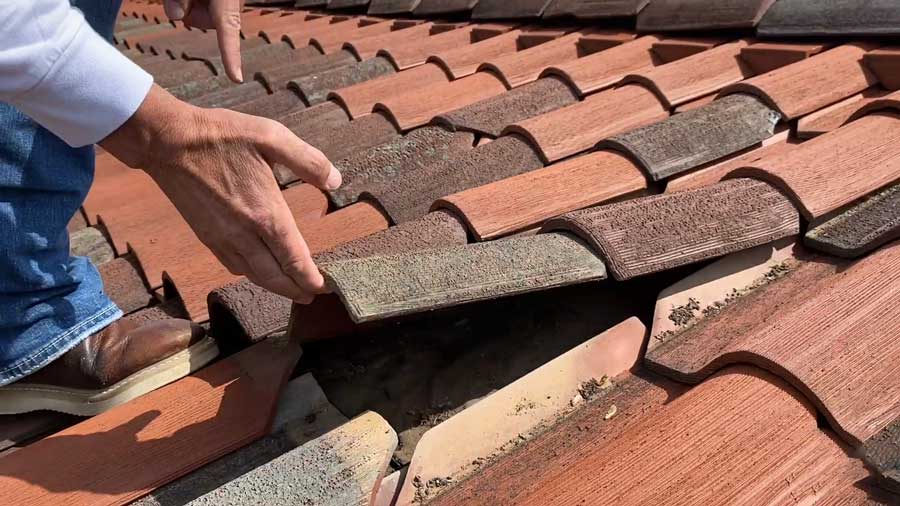
Solution: To deal with such type of problems, you need to check the condition of tiles and joints between them, if you come across any damages, repair it as soon as possible. Additionally, assess the fixing arrangement of the tiles and address any irregularities you may find. To ensure proper stability, consider using tile screws to securely hold the tiles in place.
3. Wall damages and leakage
If the exterior wall of a building is not properly maintained, including inadequate plastering and painting, heavy rain can cause various types of damage such as blistering, efflorescence, and flaking.
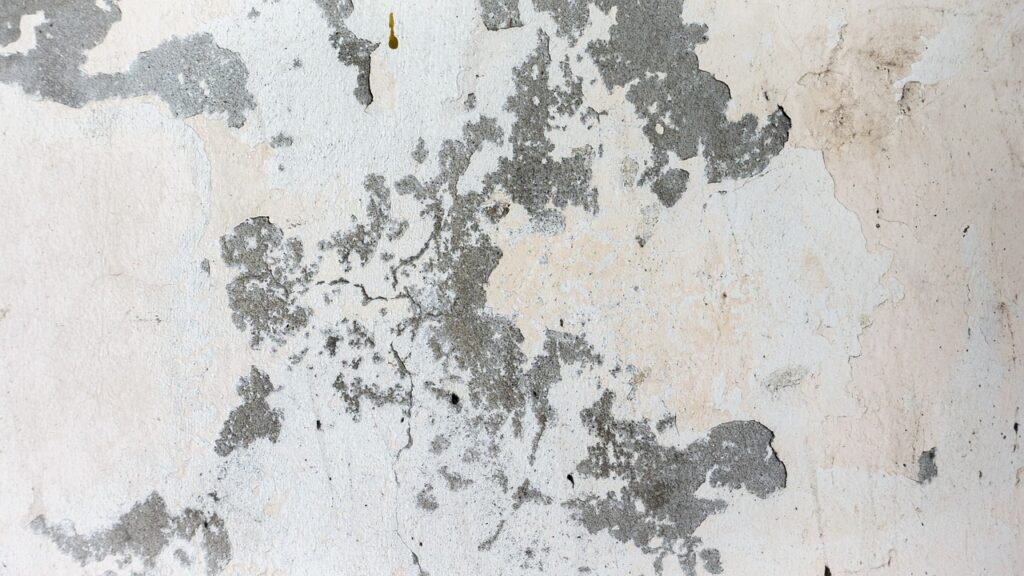
Additionally, minor cracks in the wall can lead to water leakage inside the rooms, resulting in an unsightly appearance and creating an unpleasant environment.
Also Read: 5 best method to repair brick wall defects
Solution:
inspect the condition of the plaster and applied paints on the exterior walls. if you come across any damages than repair it. Check the crack in wall and fill them using suitable grout material.
4. Gutter Drain Clog
Clogging of drainage during the rainy season is a common problem, with the clogging of the main gutter being a major headache. This issue arises due to inadequate cleaning of the roof and drainage pipes. The accumulation of unnecessary waste materials in the gutter leads to water clogs.

Solution: It is advisable to conduct pre-monsoon maintenance to ensure the smooth functioning of your gutter system. Check the condition of the gutter and clean it regularly to prevent any blockages. Additionally, make sure to maintain the proper slope of the gutter to facilitate easy drainage of water.
5. Vegetation
During the monsoon season, unwanted plants can grow over the roof and other exposed surfaces of a building. This growth can cause cracks in the structure, reduce its durability, and create an unsightly aesthetic view.

Solution: Ensure thorough cleaning of the roof and refrain from storing any equipment or waste materials on it.
6. Dampness in Basement
During the rainy season, the groundwater level rises, leading to dampness in the basement and ground floor of the building.
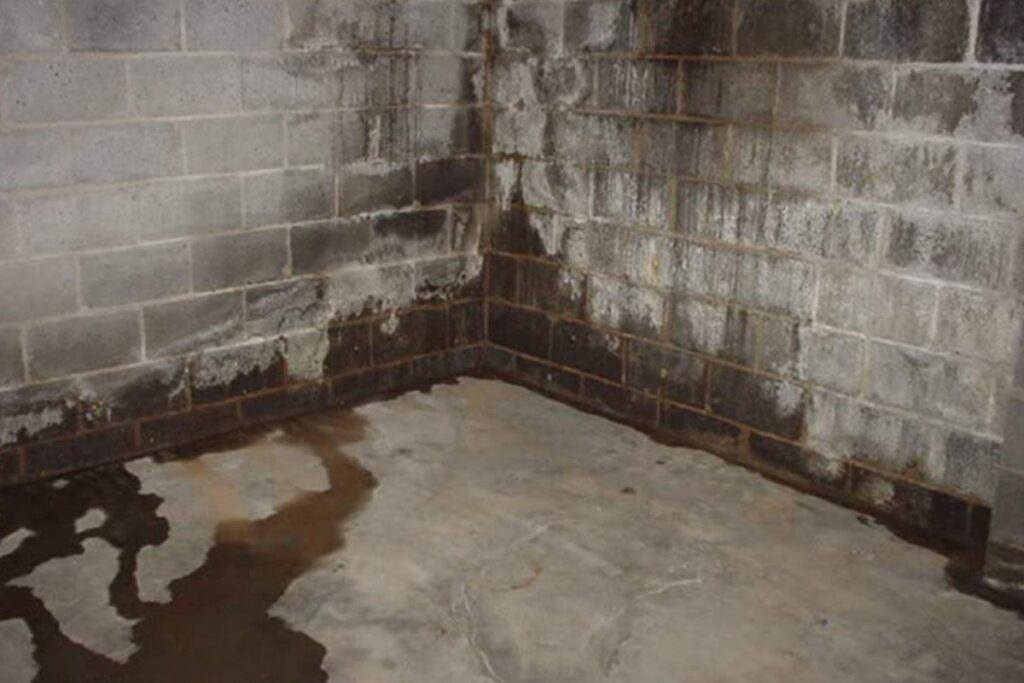
Solution: For the basement, it is recommended to apply a suitable damp-proofing solution to prevent dampness. As for the ground floor, installing tiles can help address such issues.
Applying a layer of cement-mortar or bituminous material as a damp-proofing measure at the plinth height level can also help prevent dampness in the walls.
Also Read: Best way to Repair Dampness and Efflorescence in wall
7. Shot circuit
Short circuit is another major problem in houses during the rainy season. It occurs due to the deterioration of wiring and the power supply system. The moisture from the rain affects the electrical appliances and the supply system, increasing the risk of short circuits or electric shocks when in use.
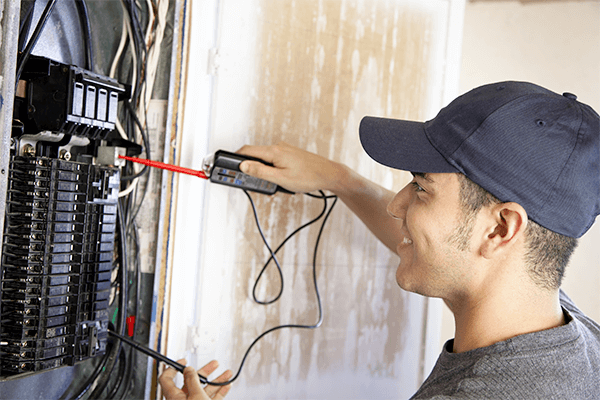
Solution: It is essential to inspect the condition of electric wiring, appliances, and the supply system regularly. Check for any electric leakage or deterioration in the system.
If any problems such as leakage, deterioration, or damage are detected, it is crucial to address them promptly. It is always recommended to seek the assistance of a qualified electrician to resolve such issues.
It is advisable to keep electric appliances away from areas of moisture. If necessary, you can cover them with plastic bags or other protective measures to prevent electric shocks/damages.
8. Moss
When it frequently rains, moss can grow in front of the house or on pathways, which should not be ignored as it can lead to accidents.

It is important to promptly clean and prevent it after rain. Leaving it unattended for a long time is not advisable.
To eliminate fungus and algae, you can use appropriate cleaning solutions based on the surface you want to clean. Allow the solution to work by letting it react, and then utilize a scrub brush or a high-pressure cleaner to remove them effectively.
So, these are the major problems that peoples are facing during monsoon in their homes. Such problems can be avoided by doing pre monsoon maintenance of building.
Also Read: Methods to Repair leakage of toilet and Bathrooms
Pre-Monsoon Maintenance for Building
To ensure your house is prepared for the monsoon season and minimize potential problems, here are some preventive maintenance steps you can take:
1. Roof inspection: Check for any loose or damaged tiles, cracks, or leaks on your roof. Repair any issues to prevent water seepage during heavy rainfall.
2. Gutters and downspouts: Clean and clear your gutters and downspouts of leaves, debris, and any blockages. This will allow rainwater to flow freely and prevent water accumulation on the roof.
3. Waterproofing: Apply a waterproof sealant to vulnerable areas such as the foundation, windows, and doors. This will help prevent water seepage and leaks.
4. Drainage system: Ensure that the drainage system around your house is functioning properly. Clear any clogs and make sure that rainwater can flow away from your property effectively.
5. Check seals and caulking: Inspect the seals around windows and doors and replace any cracked or worn-out caulking. Proper seals will prevent water from entering your house during heavy rain.
6. Exterior walls: Check for any cracks or gaps in the exterior walls. Fill them with appropriate sealants or mortar to prevent water seepage.
7. Basement and crawl spaces: Inspect the basement and crawl spaces for any signs of moisture or leaks. Repair any cracks in the foundation and consider using a waterproofing solution if necessary.
8. Electrical system: Ensure that all electrical connections, wiring, and outlets are safe and properly insulated. Consider installing surge protectors to safeguard against power surges during storms.
9. Landscaping: Trim tree branches that are close to your house to minimize the risk of them falling and causing damage during heavy winds. Also, clear your yard of any debris or objects that may obstruct water flow.
10. Emergency preparedness: Prepare an emergency kit with essentials like flashlights, batteries, candles, and a first aid kit. Familiarize yourself with emergency procedures in case of power outages or severe weather conditions.
By following these Pre-monsoon maintenance checklists, you can protect your house from potential problems caused by the monsoon season.
Also Read: Causes & Effect of Dampness in building
Dear Visitor, Join our Telegram Group for such type of useful information, tips and tricks, solution, etc. of structures. Join us to get notified as soon as possible.

I am a Professional Civil & Structural Engineer having more than 4 years of experience in Engineering, Procurement and Construction industry. Here i sharing the latest updates of EPC Projects and Construction News.

